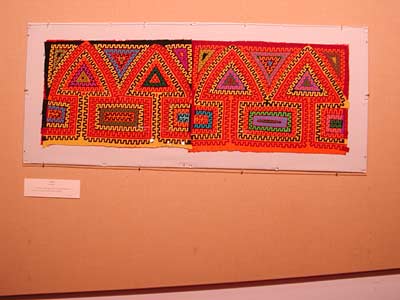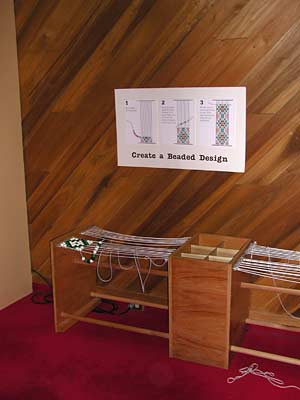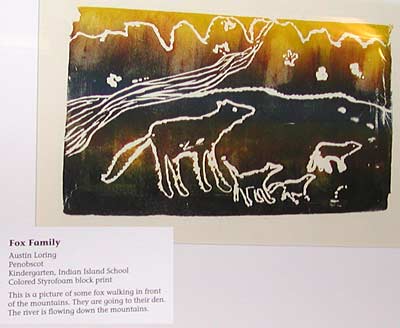The basket sale was right among the exhibits in the Hudson Museum at U. Maine Orono. We were very impressed with the museum. It’s bigger than the Idaho State U. Museum, we thought, and seems more concentrated on just a few topics, mostly in ethnology.
One of the exhibits I liked most, though I didn’t get a chance to read through it all (I was talking to the Dine, maybe that’s Navajo to you, basketmaker sitting in front of it), was about Northwest coast native art — have you seen a killer whale? It explained what all the different motifs that show up in that Haida, etc., art mean and why they all make sense. Though those paintings don’t look to me like killer whales, I was convinced that if I studied all the words, pictures, and artifacts in that exhibit, I would understand what the artists were doing.
Another exhibit upstairs had a Navajo (I think the exhibit said that, whether or not the people nowadays would rather be called Dine) rug loom with a weaving in progress, with a big swastika motif in the middle. There was a label next to it, possibly not large enough to be sure to catch your attention, about swastikas, saying that the motif had been around for a long time before the Nazis used it, and that you had to look at in context. If you see the symbol in a Hindu or Navajo context, you have to fight off your impulse to think it belongs to the Nazis. The “here it is, deal with it, if you’re offended that’s your problem, not the symbol’s problem” attitude reminds me of the Maine Public Broadcasting system’s disclaimer before “This American Life” that says “some of our listeners may find the following program very offensive, discretion is advised” (but we’re broadcasting it.)
The Hudson Museum has a huge collection of molas. They’re a kind of applique fabric art from islands off the coast of Panama. It seems that a woman who was one of the world’s authorities on them was a benefactor of the museum and donated her collection. Here are two of the most colorful:

There was a lot more on Panama, too.
One hands-on kid-friendly exhibit was about bead weaving. You know those indian beadcraft looms? I had one when I was a kid, but only had the patience to ever make one thing with it. It seemed like really slow work to me then, and took all the manual dexterity that I had and maybe a little more. This one works with wooden beads an inch in diameter instead of those tiny glass beads and light nylon rope instead of sewing thread. What a good idea! You can really understand what the structure is.

The last thing I want to show you is from an exhibit of art by Penobscot kids. The art was displayed in good quality frames and mattes, which of course helps. Arlene was most impressed by the whole thing — the presence in the museum, the care in preparing the exhibit, and the quality of the art. Since the eraser carvers were recently talking about how kids all learn about printing with styrofoam plates, I thought I’d give you this one. Kindergarten! I was blown away. I photoshopped it just to move the label over the matte so you could see the picture and read the label in a reasonable-sized file.
